Culture Care Model
VerifiedAdded on 2022/12/29
|8
|1494
|3
AI Summary
This document discusses the Culture Care Model and its application in nursing care. It explores Leininger's Culture Care Theory and Watson's Transpersonal Caring relationship theory. Case studies are provided to illustrate the practical implementation of these theories.
Contribute Materials
Your contribution can guide someone’s learning journey. Share your
documents today.
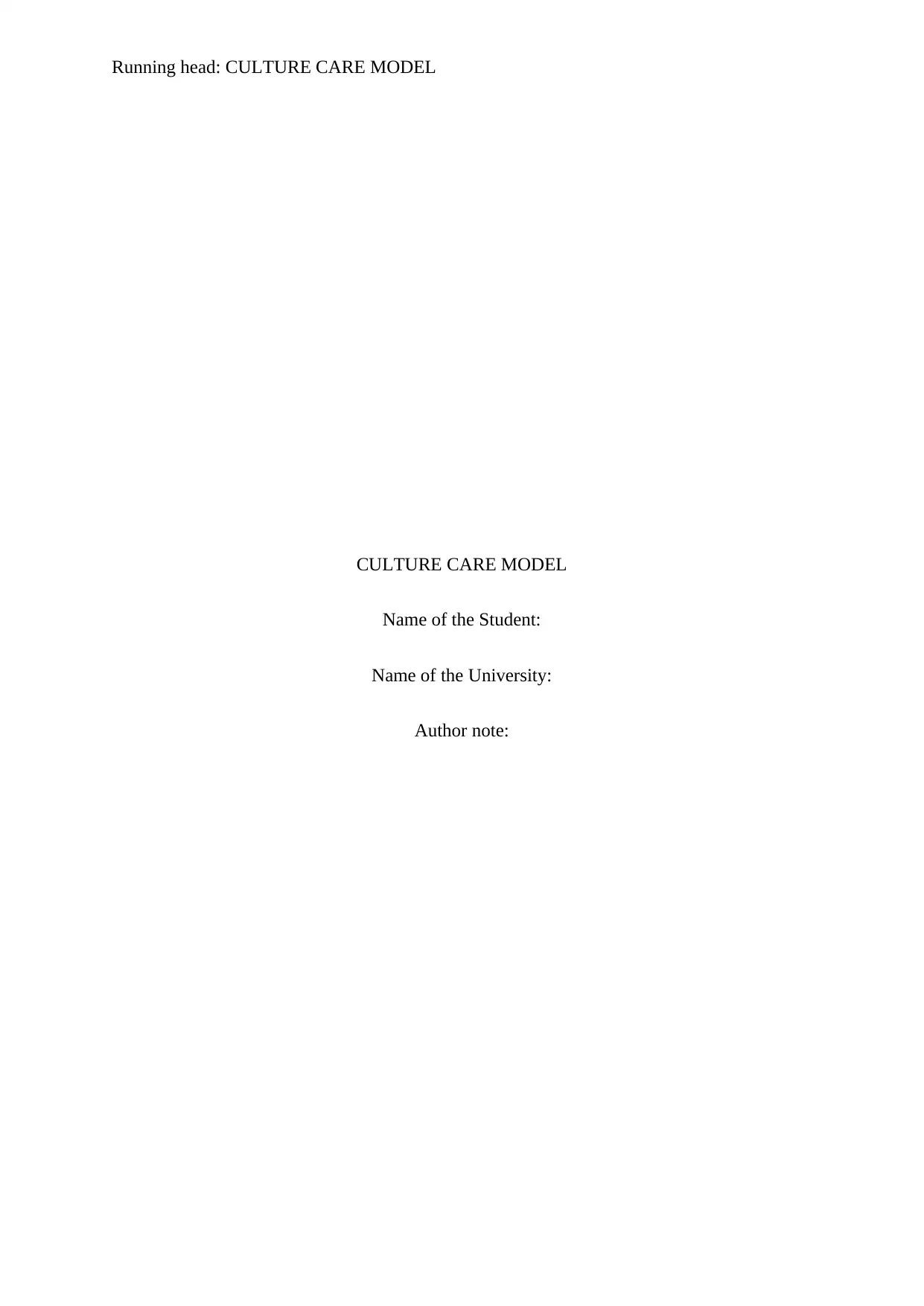
Running head: CULTURE CARE MODEL
CULTURE CARE MODEL
Name of the Student:
Name of the University:
Author note:
CULTURE CARE MODEL
Name of the Student:
Name of the University:
Author note:
Secure Best Marks with AI Grader
Need help grading? Try our AI Grader for instant feedback on your assignments.
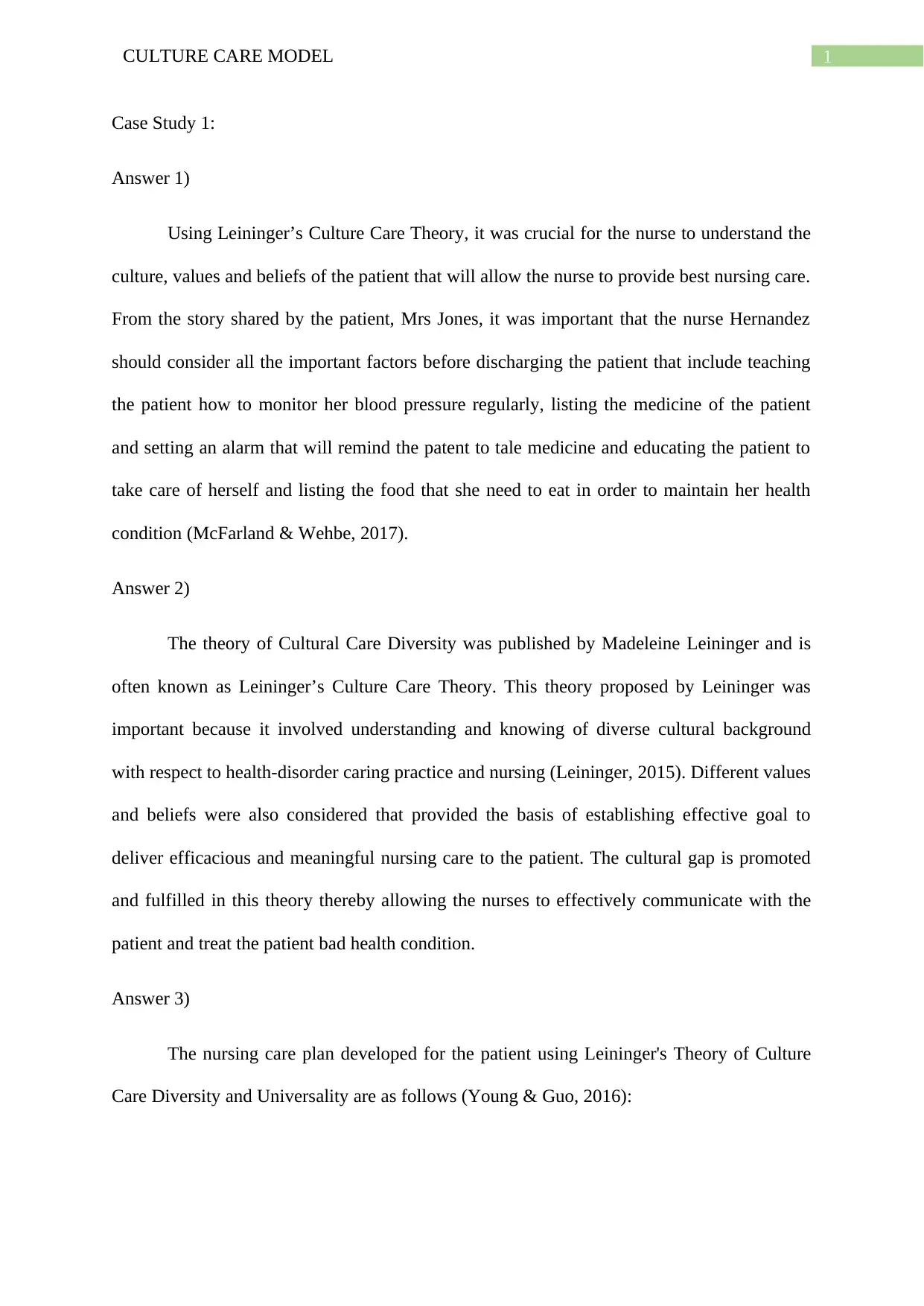
1CULTURE CARE MODEL
Case Study 1:
Answer 1)
Using Leininger’s Culture Care Theory, it was crucial for the nurse to understand the
culture, values and beliefs of the patient that will allow the nurse to provide best nursing care.
From the story shared by the patient, Mrs Jones, it was important that the nurse Hernandez
should consider all the important factors before discharging the patient that include teaching
the patient how to monitor her blood pressure regularly, listing the medicine of the patient
and setting an alarm that will remind the patent to tale medicine and educating the patient to
take care of herself and listing the food that she need to eat in order to maintain her health
condition (McFarland & Wehbe, 2017).
Answer 2)
The theory of Cultural Care Diversity was published by Madeleine Leininger and is
often known as Leininger’s Culture Care Theory. This theory proposed by Leininger was
important because it involved understanding and knowing of diverse cultural background
with respect to health-disorder caring practice and nursing (Leininger, 2015). Different values
and beliefs were also considered that provided the basis of establishing effective goal to
deliver efficacious and meaningful nursing care to the patient. The cultural gap is promoted
and fulfilled in this theory thereby allowing the nurses to effectively communicate with the
patient and treat the patient bad health condition.
Answer 3)
The nursing care plan developed for the patient using Leininger's Theory of Culture
Care Diversity and Universality are as follows (Young & Guo, 2016):
Case Study 1:
Answer 1)
Using Leininger’s Culture Care Theory, it was crucial for the nurse to understand the
culture, values and beliefs of the patient that will allow the nurse to provide best nursing care.
From the story shared by the patient, Mrs Jones, it was important that the nurse Hernandez
should consider all the important factors before discharging the patient that include teaching
the patient how to monitor her blood pressure regularly, listing the medicine of the patient
and setting an alarm that will remind the patent to tale medicine and educating the patient to
take care of herself and listing the food that she need to eat in order to maintain her health
condition (McFarland & Wehbe, 2017).
Answer 2)
The theory of Cultural Care Diversity was published by Madeleine Leininger and is
often known as Leininger’s Culture Care Theory. This theory proposed by Leininger was
important because it involved understanding and knowing of diverse cultural background
with respect to health-disorder caring practice and nursing (Leininger, 2015). Different values
and beliefs were also considered that provided the basis of establishing effective goal to
deliver efficacious and meaningful nursing care to the patient. The cultural gap is promoted
and fulfilled in this theory thereby allowing the nurses to effectively communicate with the
patient and treat the patient bad health condition.
Answer 3)
The nursing care plan developed for the patient using Leininger's Theory of Culture
Care Diversity and Universality are as follows (Young & Guo, 2016):
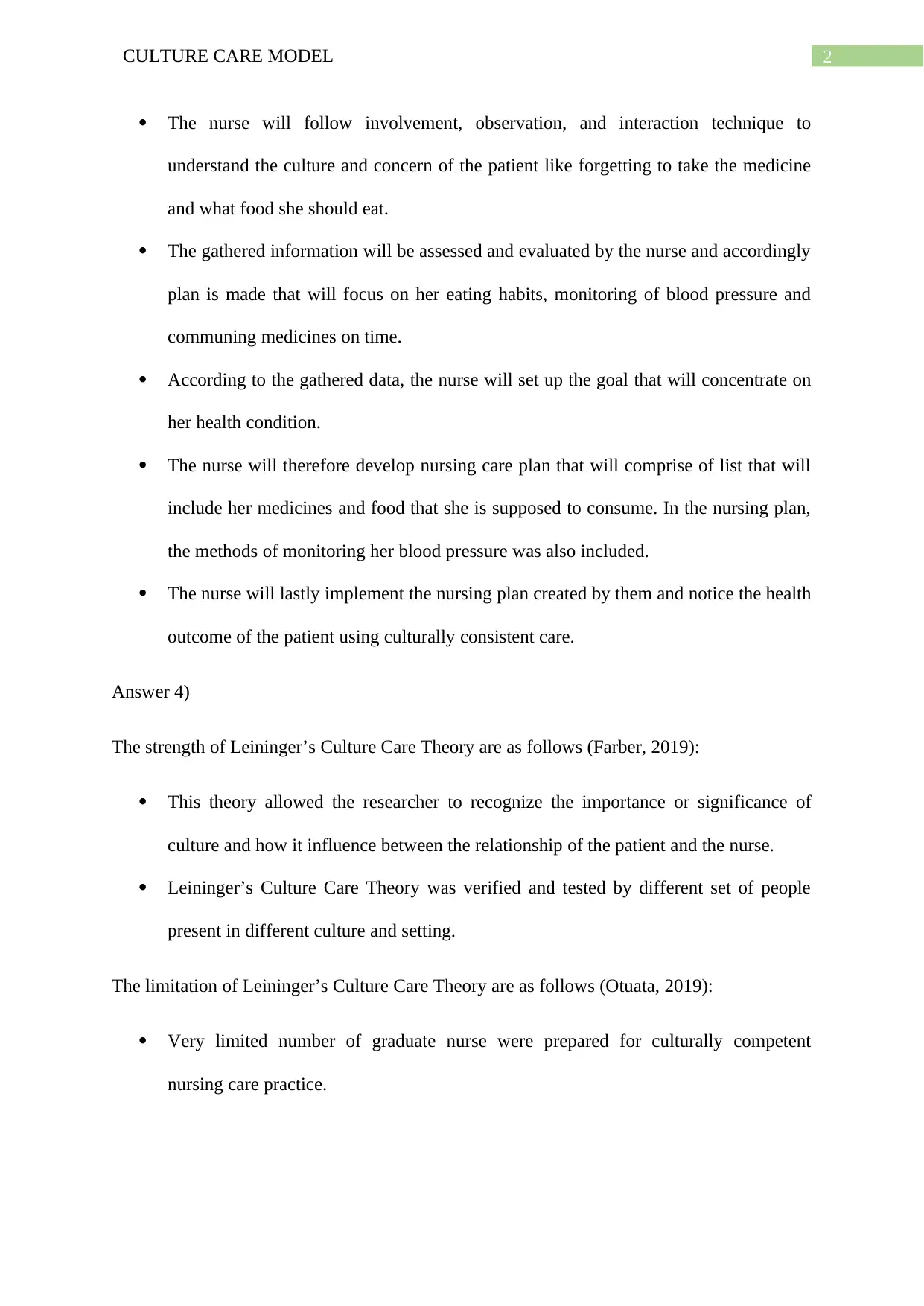
2CULTURE CARE MODEL
The nurse will follow involvement, observation, and interaction technique to
understand the culture and concern of the patient like forgetting to take the medicine
and what food she should eat.
The gathered information will be assessed and evaluated by the nurse and accordingly
plan is made that will focus on her eating habits, monitoring of blood pressure and
communing medicines on time.
According to the gathered data, the nurse will set up the goal that will concentrate on
her health condition.
The nurse will therefore develop nursing care plan that will comprise of list that will
include her medicines and food that she is supposed to consume. In the nursing plan,
the methods of monitoring her blood pressure was also included.
The nurse will lastly implement the nursing plan created by them and notice the health
outcome of the patient using culturally consistent care.
Answer 4)
The strength of Leininger’s Culture Care Theory are as follows (Farber, 2019):
This theory allowed the researcher to recognize the importance or significance of
culture and how it influence between the relationship of the patient and the nurse.
Leininger’s Culture Care Theory was verified and tested by different set of people
present in different culture and setting.
The limitation of Leininger’s Culture Care Theory are as follows (Otuata, 2019):
Very limited number of graduate nurse were prepared for culturally competent
nursing care practice.
The nurse will follow involvement, observation, and interaction technique to
understand the culture and concern of the patient like forgetting to take the medicine
and what food she should eat.
The gathered information will be assessed and evaluated by the nurse and accordingly
plan is made that will focus on her eating habits, monitoring of blood pressure and
communing medicines on time.
According to the gathered data, the nurse will set up the goal that will concentrate on
her health condition.
The nurse will therefore develop nursing care plan that will comprise of list that will
include her medicines and food that she is supposed to consume. In the nursing plan,
the methods of monitoring her blood pressure was also included.
The nurse will lastly implement the nursing plan created by them and notice the health
outcome of the patient using culturally consistent care.
Answer 4)
The strength of Leininger’s Culture Care Theory are as follows (Farber, 2019):
This theory allowed the researcher to recognize the importance or significance of
culture and how it influence between the relationship of the patient and the nurse.
Leininger’s Culture Care Theory was verified and tested by different set of people
present in different culture and setting.
The limitation of Leininger’s Culture Care Theory are as follows (Otuata, 2019):
Very limited number of graduate nurse were prepared for culturally competent
nursing care practice.
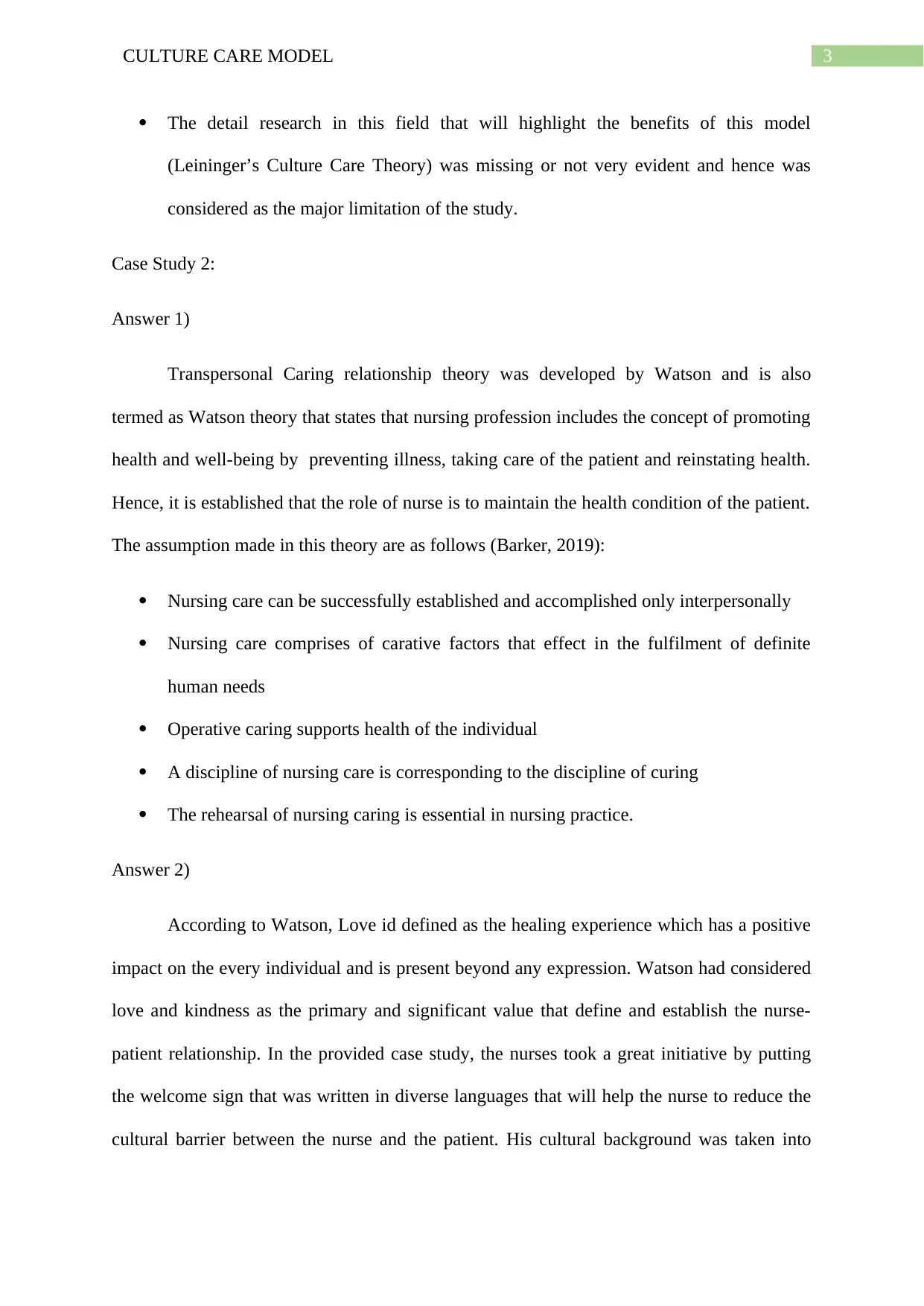
3CULTURE CARE MODEL
The detail research in this field that will highlight the benefits of this model
(Leininger’s Culture Care Theory) was missing or not very evident and hence was
considered as the major limitation of the study.
Case Study 2:
Answer 1)
Transpersonal Caring relationship theory was developed by Watson and is also
termed as Watson theory that states that nursing profession includes the concept of promoting
health and well-being by preventing illness, taking care of the patient and reinstating health.
Hence, it is established that the role of nurse is to maintain the health condition of the patient.
The assumption made in this theory are as follows (Barker, 2019):
Nursing care can be successfully established and accomplished only interpersonally
Nursing care comprises of carative factors that effect in the fulfilment of definite
human needs
Operative caring supports health of the individual
A discipline of nursing care is corresponding to the discipline of curing
The rehearsal of nursing caring is essential in nursing practice.
Answer 2)
According to Watson, Love id defined as the healing experience which has a positive
impact on the every individual and is present beyond any expression. Watson had considered
love and kindness as the primary and significant value that define and establish the nurse-
patient relationship. In the provided case study, the nurses took a great initiative by putting
the welcome sign that was written in diverse languages that will help the nurse to reduce the
cultural barrier between the nurse and the patient. His cultural background was taken into
The detail research in this field that will highlight the benefits of this model
(Leininger’s Culture Care Theory) was missing or not very evident and hence was
considered as the major limitation of the study.
Case Study 2:
Answer 1)
Transpersonal Caring relationship theory was developed by Watson and is also
termed as Watson theory that states that nursing profession includes the concept of promoting
health and well-being by preventing illness, taking care of the patient and reinstating health.
Hence, it is established that the role of nurse is to maintain the health condition of the patient.
The assumption made in this theory are as follows (Barker, 2019):
Nursing care can be successfully established and accomplished only interpersonally
Nursing care comprises of carative factors that effect in the fulfilment of definite
human needs
Operative caring supports health of the individual
A discipline of nursing care is corresponding to the discipline of curing
The rehearsal of nursing caring is essential in nursing practice.
Answer 2)
According to Watson, Love id defined as the healing experience which has a positive
impact on the every individual and is present beyond any expression. Watson had considered
love and kindness as the primary and significant value that define and establish the nurse-
patient relationship. In the provided case study, the nurses took a great initiative by putting
the welcome sign that was written in diverse languages that will help the nurse to reduce the
cultural barrier between the nurse and the patient. His cultural background was taken into
Secure Best Marks with AI Grader
Need help grading? Try our AI Grader for instant feedback on your assignments.
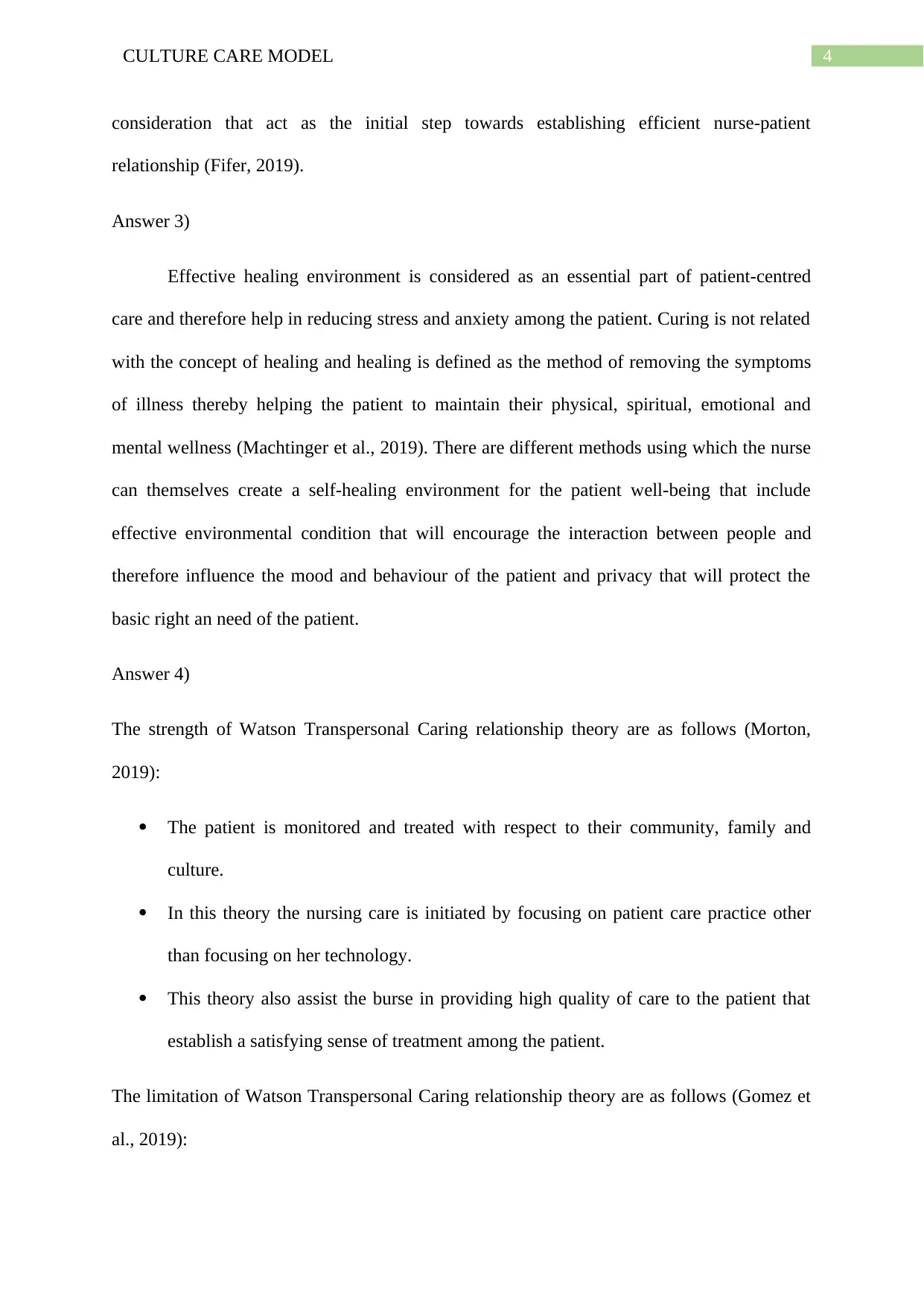
4CULTURE CARE MODEL
consideration that act as the initial step towards establishing efficient nurse-patient
relationship (Fifer, 2019).
Answer 3)
Effective healing environment is considered as an essential part of patient-centred
care and therefore help in reducing stress and anxiety among the patient. Curing is not related
with the concept of healing and healing is defined as the method of removing the symptoms
of illness thereby helping the patient to maintain their physical, spiritual, emotional and
mental wellness (Machtinger et al., 2019). There are different methods using which the nurse
can themselves create a self-healing environment for the patient well-being that include
effective environmental condition that will encourage the interaction between people and
therefore influence the mood and behaviour of the patient and privacy that will protect the
basic right an need of the patient.
Answer 4)
The strength of Watson Transpersonal Caring relationship theory are as follows (Morton,
2019):
The patient is monitored and treated with respect to their community, family and
culture.
In this theory the nursing care is initiated by focusing on patient care practice other
than focusing on her technology.
This theory also assist the burse in providing high quality of care to the patient that
establish a satisfying sense of treatment among the patient.
The limitation of Watson Transpersonal Caring relationship theory are as follows (Gomez et
al., 2019):
consideration that act as the initial step towards establishing efficient nurse-patient
relationship (Fifer, 2019).
Answer 3)
Effective healing environment is considered as an essential part of patient-centred
care and therefore help in reducing stress and anxiety among the patient. Curing is not related
with the concept of healing and healing is defined as the method of removing the symptoms
of illness thereby helping the patient to maintain their physical, spiritual, emotional and
mental wellness (Machtinger et al., 2019). There are different methods using which the nurse
can themselves create a self-healing environment for the patient well-being that include
effective environmental condition that will encourage the interaction between people and
therefore influence the mood and behaviour of the patient and privacy that will protect the
basic right an need of the patient.
Answer 4)
The strength of Watson Transpersonal Caring relationship theory are as follows (Morton,
2019):
The patient is monitored and treated with respect to their community, family and
culture.
In this theory the nursing care is initiated by focusing on patient care practice other
than focusing on her technology.
This theory also assist the burse in providing high quality of care to the patient that
establish a satisfying sense of treatment among the patient.
The limitation of Watson Transpersonal Caring relationship theory are as follows (Gomez et
al., 2019):
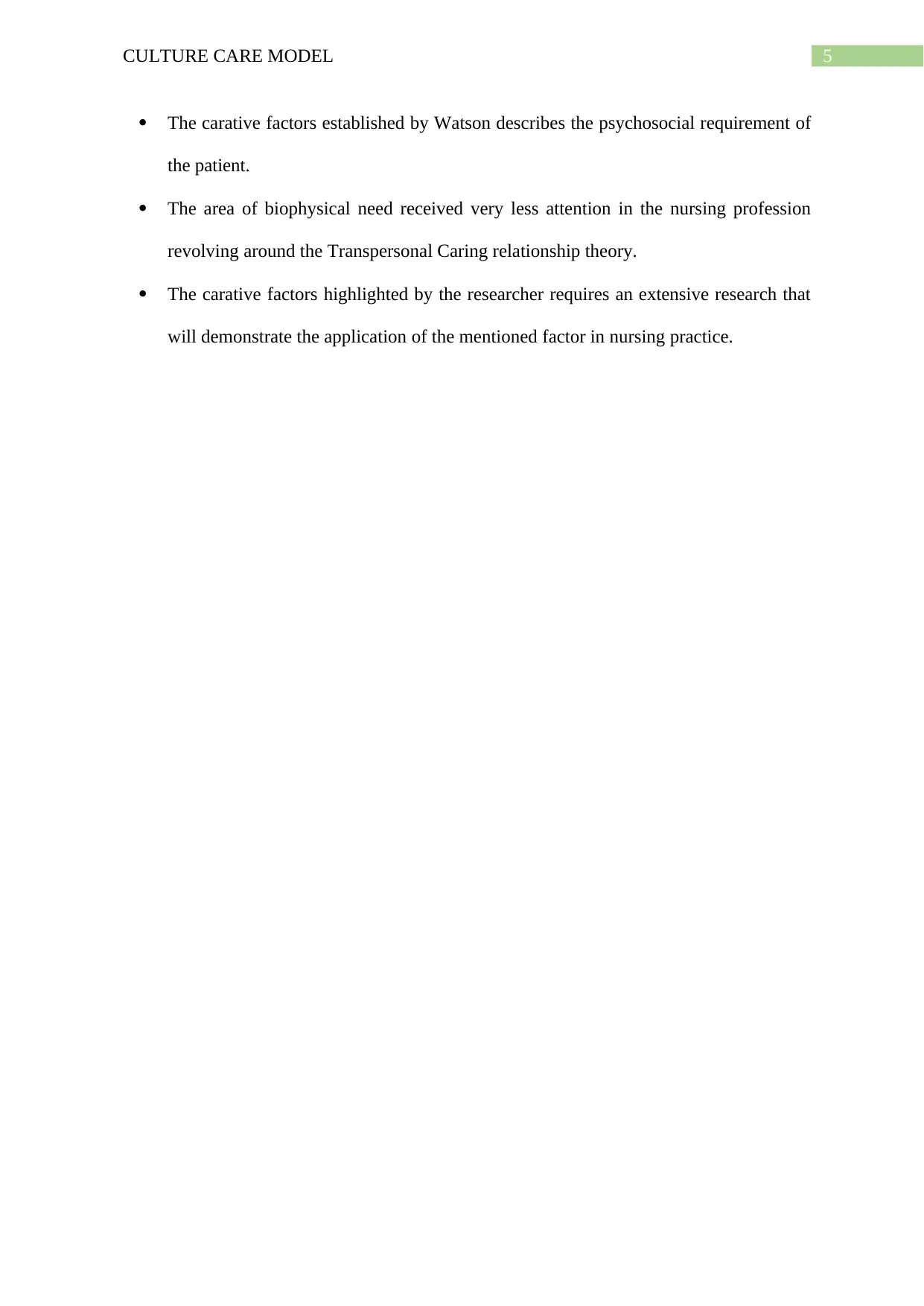
5CULTURE CARE MODEL
The carative factors established by Watson describes the psychosocial requirement of
the patient.
The area of biophysical need received very less attention in the nursing profession
revolving around the Transpersonal Caring relationship theory.
The carative factors highlighted by the researcher requires an extensive research that
will demonstrate the application of the mentioned factor in nursing practice.
The carative factors established by Watson describes the psychosocial requirement of
the patient.
The area of biophysical need received very less attention in the nursing profession
revolving around the Transpersonal Caring relationship theory.
The carative factors highlighted by the researcher requires an extensive research that
will demonstrate the application of the mentioned factor in nursing practice.
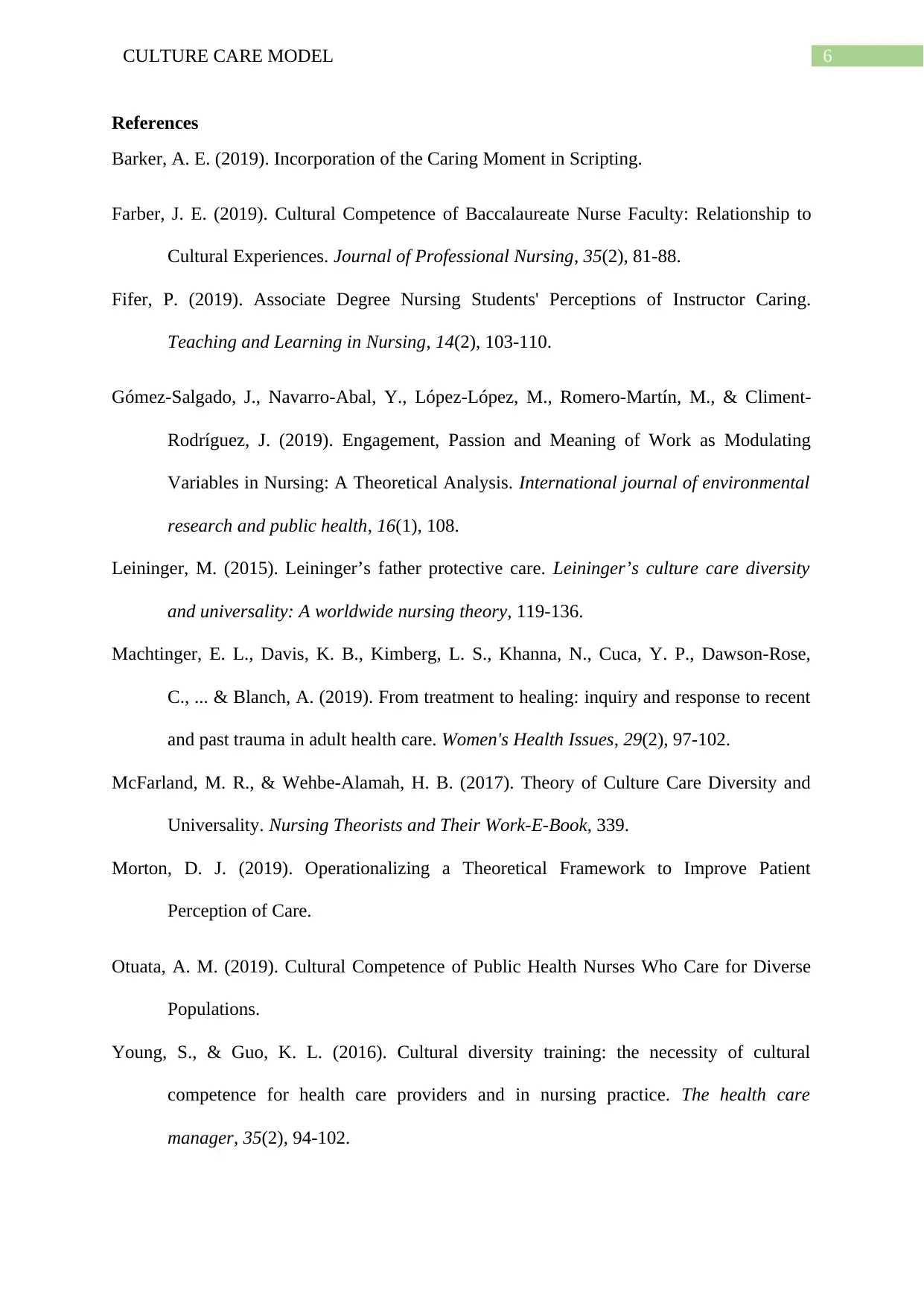
6CULTURE CARE MODEL
References
Barker, A. E. (2019). Incorporation of the Caring Moment in Scripting.
Farber, J. E. (2019). Cultural Competence of Baccalaureate Nurse Faculty: Relationship to
Cultural Experiences. Journal of Professional Nursing, 35(2), 81-88.
Fifer, P. (2019). Associate Degree Nursing Students' Perceptions of Instructor Caring.
Teaching and Learning in Nursing, 14(2), 103-110.
Gómez-Salgado, J., Navarro-Abal, Y., López-López, M., Romero-Martín, M., & Climent-
Rodríguez, J. (2019). Engagement, Passion and Meaning of Work as Modulating
Variables in Nursing: A Theoretical Analysis. International journal of environmental
research and public health, 16(1), 108.
Leininger, M. (2015). Leininger’s father protective care. Leininger’s culture care diversity
and universality: A worldwide nursing theory, 119-136.
Machtinger, E. L., Davis, K. B., Kimberg, L. S., Khanna, N., Cuca, Y. P., Dawson-Rose,
C., ... & Blanch, A. (2019). From treatment to healing: inquiry and response to recent
and past trauma in adult health care. Women's Health Issues, 29(2), 97-102.
McFarland, M. R., & Wehbe-Alamah, H. B. (2017). Theory of Culture Care Diversity and
Universality. Nursing Theorists and Their Work-E-Book, 339.
Morton, D. J. (2019). Operationalizing a Theoretical Framework to Improve Patient
Perception of Care.
Otuata, A. M. (2019). Cultural Competence of Public Health Nurses Who Care for Diverse
Populations.
Young, S., & Guo, K. L. (2016). Cultural diversity training: the necessity of cultural
competence for health care providers and in nursing practice. The health care
manager, 35(2), 94-102.
References
Barker, A. E. (2019). Incorporation of the Caring Moment in Scripting.
Farber, J. E. (2019). Cultural Competence of Baccalaureate Nurse Faculty: Relationship to
Cultural Experiences. Journal of Professional Nursing, 35(2), 81-88.
Fifer, P. (2019). Associate Degree Nursing Students' Perceptions of Instructor Caring.
Teaching and Learning in Nursing, 14(2), 103-110.
Gómez-Salgado, J., Navarro-Abal, Y., López-López, M., Romero-Martín, M., & Climent-
Rodríguez, J. (2019). Engagement, Passion and Meaning of Work as Modulating
Variables in Nursing: A Theoretical Analysis. International journal of environmental
research and public health, 16(1), 108.
Leininger, M. (2015). Leininger’s father protective care. Leininger’s culture care diversity
and universality: A worldwide nursing theory, 119-136.
Machtinger, E. L., Davis, K. B., Kimberg, L. S., Khanna, N., Cuca, Y. P., Dawson-Rose,
C., ... & Blanch, A. (2019). From treatment to healing: inquiry and response to recent
and past trauma in adult health care. Women's Health Issues, 29(2), 97-102.
McFarland, M. R., & Wehbe-Alamah, H. B. (2017). Theory of Culture Care Diversity and
Universality. Nursing Theorists and Their Work-E-Book, 339.
Morton, D. J. (2019). Operationalizing a Theoretical Framework to Improve Patient
Perception of Care.
Otuata, A. M. (2019). Cultural Competence of Public Health Nurses Who Care for Diverse
Populations.
Young, S., & Guo, K. L. (2016). Cultural diversity training: the necessity of cultural
competence for health care providers and in nursing practice. The health care
manager, 35(2), 94-102.
Paraphrase This Document
Need a fresh take? Get an instant paraphrase of this document with our AI Paraphraser

7CULTURE CARE MODEL
1 out of 8
Related Documents
Your All-in-One AI-Powered Toolkit for Academic Success.
+13062052269
info@desklib.com
Available 24*7 on WhatsApp / Email
![[object Object]](/_next/static/media/star-bottom.7253800d.svg)
Unlock your academic potential
© 2024 | Zucol Services PVT LTD | All rights reserved.





